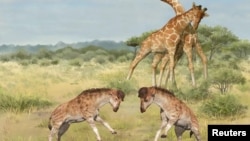The ancient bones of a distant ancestor of the modern giraffe are offering scientists evidence about why the animal’s long neck developed.
Scientists say these fossils, which were discovered in China, suggest a long neck was helpful for competitions between males.
Researchers recently described the fossils including a thick skull, or bones of the head, and strong neck bones. They belonged to an early member of the giraffe family called Discokeryx xiezhi. The creature lived about 17 million years ago in the Xinjiang area in northwestern China.
Discokeryx's solidly-built skull and strong neck bones were well adapted to high-speed head-to-head crashes. They were like competitions seen among males of some mammal species for female mates, the researchers said.
They explained that Discokeryx had the most complex neck bones of any mammal. This was the case for joints between the head and neck as well as between the individual neck bones.
Discokeryx means "disc-horn," while xiezhi is a single-horned creature in traditional Chinese stories. Discokeryx's skull had a large round-shaped and thick bone structure known as ossicone. That is the name for the horn-like objects on the top of giraffe's heads.
Shi-Qi Wang Wang , lead writer of the study published in Science, said, "Ossicones, like horns and antlers, usually serve as weapons for males fighting for mates."
Study co-writer Jin Meng said the traditional idea about why modern giraffes have such long necks is that long necks are useful for eating tree leaves. "Discokeryx most likely ate grasses," Meng explained.
Meng added, "This new finding shows that, in the giraffe family, members do different things in their early evolution. The new species represents an extreme example in which the neck ... becomes very thick to absorb the power and impact from powerful head-butting."
Another idea about giraffe neck evolution - one supported by Discokeryx's bone structure - is that neck lengthening was driven by behavior shown in competition for mates like the "necking" seen in giraffes today. In such competitions, males violently strike each other with their necks. Longer-necked males often win these fights.
"If a male giraffe has a shorter neck, then the female may refuse the mating request of the male," Wang said.
Neck lengthening, or elongation, independently evolved among several animal groups hundreds of millions of years ago.
Discokeryx, the researchers said, may offer information about the early developments of giraffe neck lengthening that took place over millions of years.
Discokeryx, however, took a different evolutionary path specialized for head-butting. It is not considered a direct ancestor of today's giraffe, but rather a side development of the giraffe family.
The modern giraffe, found in Africa south of the Sahara Desert, is the world's tallest living land animal. Males can grow up to 5.5 meters tall and females up to 4.3 meters tall. A giraffe's neck, stretching about 1.8 meters, has just seven neck bones like other mammals.
Discokeryx lived in open grasslands with small groups of trees during a time known as the Miocene period. It lived alongside ancient elephants, rhinos, pigs, deer, and horses. Predators at the time included saber-toothed cats, hyenas and a member of a mammalian group called "dog bears" - a creature as big as a modern polar bear.
I’m John Russell.
Will Dunham reported on this story for Reuters. John Russell adapted it for VOA Learning English.
____________________________________________________________________
Words in This Story
giraffe – n. a very tall African animal that has an extremely long neck and legs
fossil – n. something (such as a leaf, skeleton, or footprint) that is from a plant or animal which lived in ancient times and that you can see in some rocks
evolution – n. the process by which changes in plants and animals happen over time
adapt—v. to change (something) so that it functions better or is better suited for a purpose
impact – n. the act or force of one thing hitting another
predator – n. an animal that lives by killing and eating other animals : an animal that preys on other animals









